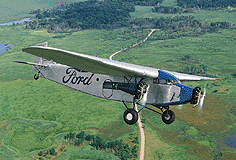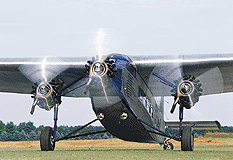

1927 Ford Trimotor 4-AT-A
Photos By Xavier Meal
Forward View/Cabin Area Forward View / Cabin Front
Forward View / Luggage Area Cockpit / Controls
Rear View / Cabin Area
One of the most important events in selling aviation to the general public was the entry of Henry Ford into aircraft manufacturing. The Ford automobile was, at the time, the symbol of reliability and it followed in the minds of a good many people that a Ford airplane would be safe to fly. The Ford Tri-motor was a rugged, all metal, dependable transport airplane which won a permanent place in aviation history.
The first 4-AT (for Air Transport) made its maiden flight on June 11, 1926. Between its first flight and July 27th 1931, 71 4-AT's were built. At the time, it was the largest civil aircraft produced in the United States. Powered by three 200-horsepower (149-kilowatt) Wright Whirlwind J4 radial engines, the 4-AT-A version of up the plane could seat up to eight passengers in its enclosed cabin, although the two pilots were exposed to the elements in their open cockpit. Called the "Tin Goose" because of its corrugated metal fuselage, it was an immediate success.
Later versions were larger and heavier, with three 220 hp Wright J-5 engines, it became a successful 12 to 14 passenger transporter. The 5-AT became the most famous of the five Ford Tri-motors. By the time Ford stopped producing aircraft in 1933, 199 Ford Tri-motors had been built. More than 100 airlines from around the world flew the Ford Tri-motor. They were used on the first transcontinental route and were flown by Transcontinental Air Transport (TAT) later to become known as (TWA.)
In addition to carrying
passengers, the Trimotors served other purposes, including carrying freight,
crop-dusting, fire fighting, advertising, and exploring remote areas. The
military version of the 4-AT, designated the C-4, was used to transport military
troops. During its years in production, which ended in 1933, Ford built
approximately 80 4-ATs and 117 5-ATs as well as a small number of later
varieties and a few military aircraft.
This Museum's Ford Tri-motor is the oldest one in existence and has been flown by Harry Brooks, Ford's Chief Pilot. This is the airplane that was used to fly Charles Lindbergh's mother to Mexico City to see her son. Charles Lindbergh along with Amelia Earhart also flew this aircraft.
Original Specifications
Ford Trimotor
4-AT-A, Serial No. 10
C-1077 and
G-CARG “Niagara” in Canada
First Flight,
September 10th, 1927
Original
selling price: $45,475
Maximum speed:
114 mph
Height: 11 ft. 9 in.
Cruising speed:
95 – 100 mph
Length: 49 ft. 10 in.
Landing speed:
59 mph
Wing span: 74 ft.
Climb: 750
ft./ min.
Wing cord: 154 in. to 92 in.
Gliding Ratio:
9.7
Wing area: 785 sq. ft.
Fuel Capacity:
231 gal.
Empty Weight: 5,937 lbs.
Range: 500
miles
Gross Weight: 9,300 lbs.
Service Ceiling:
15,000 ft.
Max. seating (exclusive of crew): 10
Go to the "Ford Tri-Motor" Website for more history on this aircraft.
Click HERE to watch a YouTube video about the ford at Oshkosh 2009.
Click HERE for a video of Amelia Earhart flying this aircraft
Click HERE for a detailed info PDF file on this aircraft